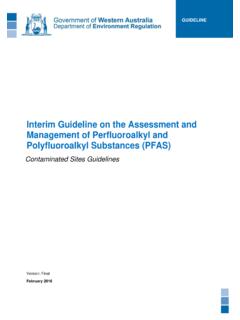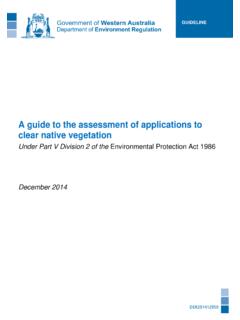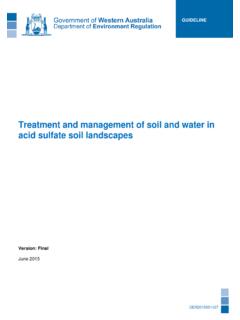Transcription of A guideline for managing the associated contaminants from ...
1 A guideline for managing the impacts of dust and associated contaminants from land development sites, contaminated sites remediation and other related activities. Department of Environment and Conservation March 2011 2010529 ADDENDUM The Department of Environment and Conservation (DEC) released an updated dust guideline in January 2011, A guideline for managing the impacts of dust and associated contaminants from land development sites, contaminated sites remediation and other related activities, January 2011 . An error was identified in Appendix 1 on page 35.
2 This error has since been corrected (See below). This document is the corrected version published in March 2011. Appendix 1: Site risk assessment/classification for activities generating uncontaminated dust Sheet 1: Site classification assessment chart Part A. Nature of site Item Score options Allocated score 1.
3 Nuisance potential of soil, when disturbed Very 2. Topography and protection provided by undisturbed vegetation Sheltered and Medium Little Exposed and wind 3. Area of site disturbed by the works Less than Between 1 and Between 5 and More than 4. Type of work being done roads or shallow roads, drains and medium depth Roads, drains, sewers and partial Bulk earthworks and deep TOTAL score for Part A Part B. Proximity of site to other land uses Item Score options Allocated score 1.
4 D istance of other land uses from site More than Between 1km and Between 100m and than 2. Effect of prevailing wind direction (at time of construction) on other land uses Not Isolated land uses affected by one wind land uses affected by one wind Dense/sensitive land uses highly affected by prevailing TOTAL score for Part B SITE CLASSIFICATION SCORE (A X B) = Table of contents GLOSSARY, ACRONYMS AND DEFINITIONS .. 1 EXECUTIVE SUMMARY .. 4 INTRODUCTION .. 5 Purpose of guideline .. 5 Application of the guideline .
5 5 SOURCES AND IMPACTS OF DUST AND OTHER AIR POLLUTANTS .. 7 Sources of dust .. 7 Physical nature of dust .. 7 Composition of dust .. 7 Health and nuisance impacts of 8 Health impacts of other air pollutants .. 9 LEGISLATIVE AND POLICY FRAMEWORK .. 11 National position .. 11 State position .. 12 Environmental Protection Act 1986 (EP Act) .. 12 Department of Environment and Conservation (DEC) .. 14 Other government agencies .. 14 Appropriate authorities for dust and other air pollution issues .. 15 DUST MANAGEMENT PROGRAM DESIGN AND DOCUMENTATION.
6 16 Introduction .. 17 Site background .. 17 Proposed works and potential impacts .. 18 Aspect and impact analysis .. 18 Site risk assessment/classification .. 19 Designing a monitoring program .. 20 Purpose of the program .. 21 Performance criteria and monitoring methods .. 21 Number and location of monitoring sites .. 26 Quality assurance/quality control (QA/QC) requirements .. 26 Stakeholder consultation .. 27 Roles and Responsibilities .. 27 Complaints management .. 27 Reporting .. 27 REFERENCES .. 31 APPENDICES .. 33 Appendix 1: Site risk assessment/classification for activities generating uncontaminated dust.
7 34 Sheet 1: Site Classification Assessment Chart .. 34 Sheet 2: Site assessment details .. 35 Sheet 3: Notes relating to Site assessment classification chart .. 36 Sheet 4: Dust management and monitoring requirements for each site classification score .. 37 Sheet 5: Notice to residents .. 40 Appendix 2: Factors influencing levels of dust and other air pollutants .. 41 Appendix 3: Dust control measures .. 42 Appendix 4: Relevant standards, monitoring methods and principles of operation .. 46 Appendix 5: Dust complaint form (example only) .. 53 Appendix 6: Contact details for DEC and DOH.
8 54 A guideline for managing the impacts of dust and associated contaminants from land development sites, contaminated sites remediation and other related activities. 1 Glossary, acronyms and definitions Air toxics Air toxics are gaseous, aerosol or particulate pollutants which are present in the air in low concentrations with characteristics such as toxicity or persistence so as to be a hazard to human, plant or animal life. Airborne particles (aerosols) Airborne Particles are suspended in the air and exist as aerosols--dust, fumes, smoke or mists.
9 These different aerosols are classified according to their processes of formation, as indicated below. However, from a health and nuisance impact perspective, particles are classified primarily by size, defined below as PM10, and TSP. Dust is an aerosol formed by mechanical subdivision of bulk material into airborne fines having the same chemical composition. Dust particles are generally solid and irregular in shape and have diameters greater than one micrometre. A fume is an aerosol of solid particles formed by condensation of vapours formed at elevated temperatures.
10 The primary particles are generally very small (less than micrometre) and have spherical or characteristic crystalline shapes. Since they may be formed in high number concentrations, they often rapidly coagulate, forming aggregate clusters of low overall density. Smoke is formed by condensation of combustion products, generally of organic materials. The particles are generally liquid droplets with diameters of less than micrometre. Mist is droplet aerosol formed by mechanical shearing of a bulk liquid; for example, by atomisation, nebulisation, bubbling, or spraying.







